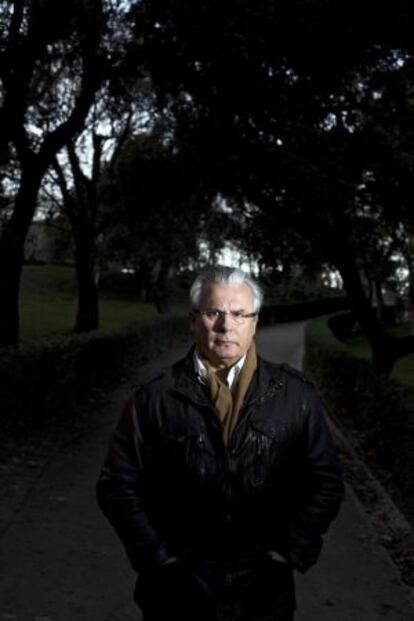“The government gave instructions to the police to say that ETA was responsible”
Former High Court Judge Baltasar Garzón recalls how he wept on seeing the scene of the tragedy


Baltasar Garzón heard the news about the bomb attacks in Madrid on March 11 while heading to the gym in his official car: “Possible attack in Atocha.” He says his first call was to Pedro Díaz-Pintado, the National Police’s deputy operative director. “He told me there was still no information on the number of victims.” He then called fellow judge Juan del Olmo, who lived in a street just behind Atocha railway station, and was still at home.
Like many Spaniards, Garzón, then still a High Court judge, remembers exactly where he was and what he was doing on the morning of March 11, 2004, when Spain suffered its worst terrorist attack. He headed for the different locations around the railway station that had been bombed, and says that despite his years of experience working in terrorism, was reduced to tears by what he saw. “It was like something out of hell. The bodies were scattered around, the railway wagons destroyed, I couldn’t hold back the tears. We were all deeply affected,” he explains, 10 years on.
Garzón says he was certain that this was not the work of ETA. “I knew right away, and then a couple of hours later a senior police officer told me that the explosive was not the kind used by ETA. This was 11am. It was just not the way that ETA worked. It made no sense, and of course this was soon proved. From the start my feeling was that Al Qaeda was behind this,” he says.
As the day wore on, Garzón says the police’s information contradicted the government’s version of events. “The official version, that this was ETA, was not the hypothesis the police were working on. I spoke to the then-director general of the National Police force, as well as with the interior minister. I remember the police director general telling me that the prime minister’s office had given instructions insisting that ETA was responsible.”
The official version, that this was ETA, was not the hypothesis the police were working on"
Garzón says that by the middle of the afternoon of March 11, the police had completely abandoned the idea that ETA was responsible, despite the government’s continued insistence in public that it was. “I believe that it was politically useful for them to do so. The attack came three days before a general election, and some might say that the government could have benefited from this; but if it wasn’t ETA, then it could change things. The fact is that the police would have issued a statement within hours of the attack saying that Jihadists were responsible, not ETA.”
The ETA conspiracy theory was kept alive for several years, and in 2006, a case was brought before the High Court that ETA was responsible, based on the use of boric acid (used by ETA) in the manufacture of the bombs. Garzón later targeted three expert witnesses with falsifying a report linking ETA to the attacks on March 11. “There are people around today who still believe that ETA was behind it, even after the men responsible blew themselves up a shortly after their hideout was discovered by the police,” he says.
Garzón prefers not to speculate on whether the March 11 attacks on Atocha railway station could have been prevented. “It is true that all those involved were known to the police,” he says, adding that some had even had their phones tapped. “But some had gone abroad, and the trail went cold. Others were under investigation for common crimes such as drug dealing… But even in hindsight, there is not a single indicator that an attack was being prepared. As happened in the United States with 9/11, the investigation was poorly coordinated, but that doesn’t mean that it could have been prevented by better police work. Nobody knows.”
Garzón says the police “did a great job,” as did the investigating magistrates, in finding the perpetrators of the attacks. “They did so in record time, and in an exemplary manner.” He is less complementary about the way the attacks were used by the country’s political parties. “The political use of the attacks was outrageous, and took things to a new low. The victims were ignored, and two kinds of category were created: victims of ETA, and victims of March 11. It was saddening and disgraceful the way that Pilar Manjón [head of the March 11 victims’ association] was treated because she stepped out of line.”
Even in hindsight, there is not a single indicator that an attack was being prepared"
Perhaps the only positive aspect of the attacks, says Garzón, is that Spain did not follow the United States in “implementing draconian legislation,” that would have curtailed rights and freedoms.
Tu suscripción se está usando en otro dispositivo
¿Quieres añadir otro usuario a tu suscripción?
Si continúas leyendo en este dispositivo, no se podrá leer en el otro.
FlechaTu suscripción se está usando en otro dispositivo y solo puedes acceder a EL PAÍS desde un dispositivo a la vez.
Si quieres compartir tu cuenta, cambia tu suscripción a la modalidad Premium, así podrás añadir otro usuario. Cada uno accederá con su propia cuenta de email, lo que os permitirá personalizar vuestra experiencia en EL PAÍS.
¿Tienes una suscripción de empresa? Accede aquí para contratar más cuentas.
En el caso de no saber quién está usando tu cuenta, te recomendamos cambiar tu contraseña aquí.
Si decides continuar compartiendo tu cuenta, este mensaje se mostrará en tu dispositivo y en el de la otra persona que está usando tu cuenta de forma indefinida, afectando a tu experiencia de lectura. Puedes consultar aquí los términos y condiciones de la suscripción digital.
Últimas noticias
There is as much life left to discover on planet Earth as that which is already known
Dozens presumed dead, around 100 injured in fire at Swiss Alps bar during New Year’s celebration
Is porn for women different from conventional porn? We spoke to those who make it
Cartagena de Indias is sinking: What can the city do to mitigate it?
Most viewed
- David King, chemist: ‘There are scientists studying how to cool the planet; nobody should stop these experiments from happening’
- Reinhard Genzel, Nobel laureate in physics: ‘One-minute videos will never give you the truth’
- Oona Chaplin: ‘I told James Cameron that I was living in a treehouse and starting a permaculture project with a friend’
- Sinaloa Cartel war is taking its toll on Los Chapitos
- The Interoceanic Train, the Mexican alternative to the Panama Canal








































